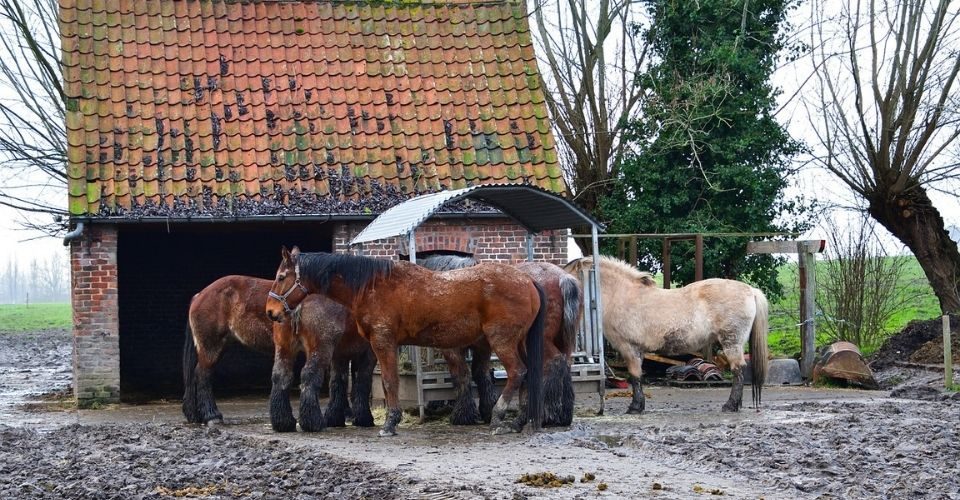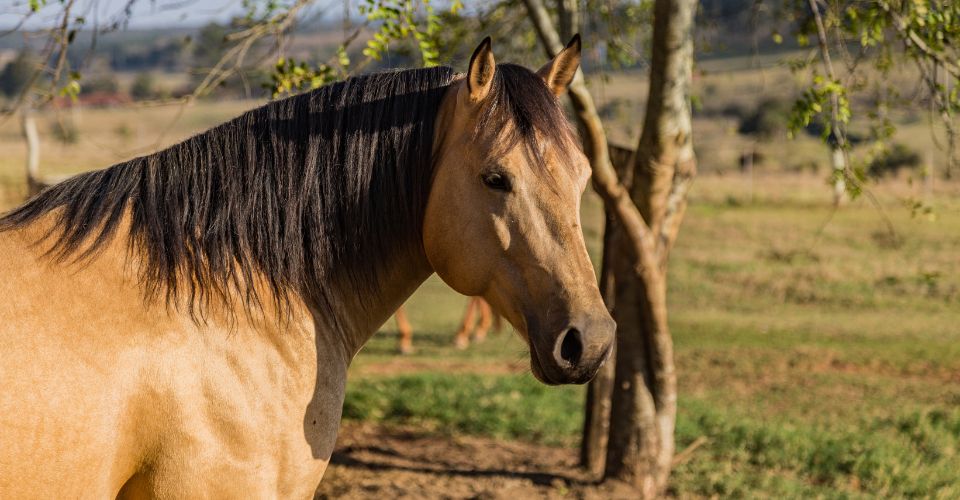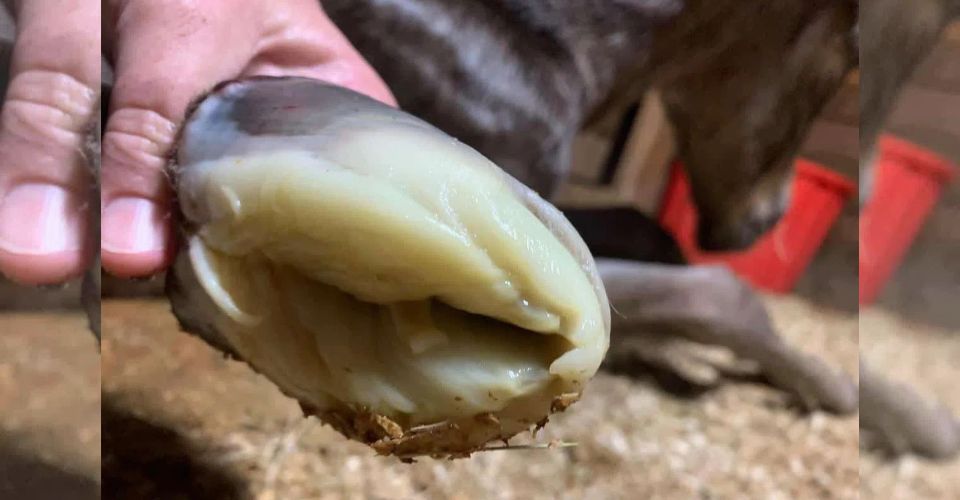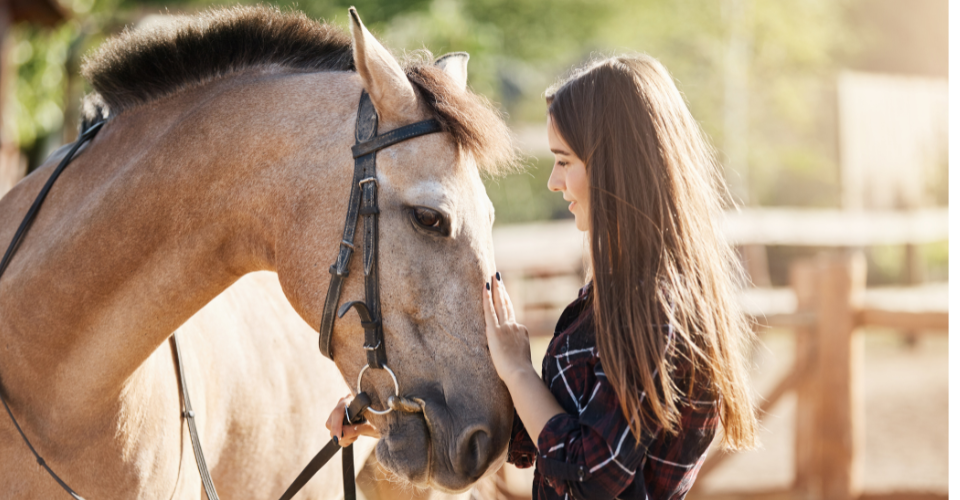What comes to your mind when you hear the term ‘Draft Horses’? A large Belgian, Shire, or Clydesdale? Most people around the world have a certain image of draft horse breeds. Many assume them to be tall and bulky, which is true. However, not all draft horse breeds are big or tall.
The world’s smallest horse recorded is a Haflinger, which falls into the draft horse breed category, and the world’s biggest horse is the Shire, also considered a draft horse breed.
Before the invention of the internal combustion engine, when there was no such thing as trucks, draft horses were used to move and transport goods. They were also used for heavy tasks like farming, plowing, forestry, and hauling huge loads. The machines, however, have not entirely replaced draft horses and are still used widely to lug, haul, carry and pull. Due to their heavy and strong physique, draft horses can easily carry heavy-duty tasks that require stamina, strength, and force.
Draft horses are also known as draught horses. The word draft means to pull or draw out carts, and that is exactly what such horses are named after. Draft horses carried out hard labor for hundreds of years. They are very tough, tolerant, and easygoing that are bred primarily for their heavy bodies and tame temperaments. Draft horses usually stand between 13 – 19 hands tall, weighing around 1,500 lbs.
Selective breeding has resulted in developing multiple distinct breeds. Some still retain the in-built traits and qualities they’re famous for, although they might not work as hard as they used to.
Generally, all draft horses have the following features:
- Giant Bodies
- Massive Muscular Strength
- Height ranging from 13 – 19 hands high
History of Draft Horses
Humans have bred horses over thousands of years for multiple purposes. Larger horses, however, were bred for war and farming during the Middle Ages. Even though horses back in the day were not as tall and big as draft horses are today, they would still successfully carry out heavy tasks.
The modern draft horses became popular in the 19th century when the need for bigger and stronger horses grew substantially. These horses were normally used for their horsepower, hauling, freight, farm work, and pulling carriages. Centuries later, after the Industrial Revolution, people started relying largely on machines. However, many still used draft horses to get the chores done.
Draft horses were essentially used to convey heavyweight equipment on the battlefield during World War I and World War II. By the end of the 1950s and the beginning of the ‘60s, workhorses nearly went extinct due to the technical and mechanical advancements in the 20th century.
Even though technology has taken over the world, the tradition of using draft horses for pleasure riding, showing, logging, and plowing small farms is not dead yet. Several dedicated horse enthusiasts and breed societies across the world went the extra mile to preserve the draft horse breeds and became the reason why draft horses are still present in the modern technology world.
The 26 Common Draft Horse Breeds
If you’re interested in gaining knowledge about the world’s famous 26 draft horse breeds, you’re at the right place. After thorough research, we have pulled together a list of the 26 most common draft horse breeds.
1. The Shire
Shires originated as a breed during the mid-1800s in the United Kingdom, although their ancestries are deep-rooted even before that. They are considered as the progenies of the Great English Horse that lugged men into battlefields. These horses are large, have incredible strength, and are typically bay, grey, or black. Shires are recognized for their slender Roman noses, well-arched neck, muscular physique, and feathering. The Shire is one of the most substantial and tallest draft horse breeds. They weigh around 850 – 1100 kgs on average and stand 16 to 18 hands tall.
As the breed advanced, they were used as a warhorse in WWI and WWII, utilized for agriculture, plowing, riding, hauling, and made a beautiful addition to horse shows as well. Their wide chest and deep shoulders make them tough and strong. Surprisingly, Shire horses can easily pull several tons. These horses hold the record for the most weight pulled by a pair of horses after pulling 50 tons in 1924.
The brilliant Shire horses worldwide have bagged several world records, including the award of the world’s largest horse that was scored by Shire Samson, who was 21.2 hands tall and weighed a striking 3,360 lbs.
Unfortunately, the number of Shires dropped radically during the 20th century. Even though the breed has become stable to some extent, it is still believed to be at risk by the Rare Breeds Survival Trust.
2. The Clydesdale
Clydesdales are one of the most famous draft horse breeds. They’re well-known for impressively pulling the world-famous Budweiser hitch.
These stunning horses are 16 – 18 hands tall and weigh between 1,700 – 2,200 pounds. They have magical eyes, a well-built physique, and perfectly arched necks. Clydesdales are usually bay in color and stand out with their silky white feathers.
The high-stepping Clydesdale horses largely appeared in the late 18th and early 19th century in Scotland. The family tree of the breed connects to the Shire and Flemish horses that were crossed with local mares.
The appearance of Clydesdale has changed over time. In the early ages, Clydesdales were utilized for farm work and road haulage. However, the demand for bulkier, stouter horses grew drastically, and the job of Clydesdale moved towards carriage driving, riding, and promotional work.
The Breeders started to form taller, narrower, and more athletic versions of the animals. Who doesn’t love the Clydesdales in the Budweiser commercial? Clydesdales are moreover used as drum horses, providing service to the British Royal Household Cavalry, and are often marched on parades.
3. Percheron
Percheron is an ancient draught horse breed that originated in the French province of Le Perche. They are thought to be the offspring of Barb and Flemish horses with an Arabian admixture. This is reflected in their gleaming outline and flimsy features.
Percherons typically weigh between 1,800 and 2,600 pounds and stand between 15 and 19 hands tall. These magnificent horses are known for their beautiful heads, elegant carriage, intelligence, strong muscled bodies, and eagerness to work. Their strength and stamina are the reasons they are so successful as riding and working horses today. Percheron horses are typically grey or black, with charming gait. They are a draught horse breed that is agile, strong, and docile. The Percheron horse possesses all of the characteristics of an excellent draught worker.
Percherons were previously used as war horses before being used for agricultural work. They were introduced to the United States in the mid-1880s and quickly became the most popular draught horse breed. They are still preferred for forestry work and carriage driving. The lighter Percheron horse is an excellent competition or police horse.
4. Suffolk Punch
This breed originated in the English counties of Norfolk and Suffolk. During WWII, the Suffolk Punch was bred for farm work as well as pulling heavyweight artillery. They were a popular choice as a workhorse on large farms, and their work ethic was admired by many. Despite being a heavy breed, the Suffolk Punch was never used in carriages. That is why they have a broad, muscular croup and a short, stocky build.
Suffolk Punches are typically 15 – 17 hands tall and weigh between 1,600 and 2,000 pounds. They are well-known for their massive, muscular physiques and thick, arching necks. Suffolk is always a chestnut color. They have a spirited, forward-moving trot. Suffolk Punches are docile, easy to care for, and have a long life span.
They rose to prominence in the early twentieth century. Despite a significant drop in population, they quickly rebounded with the hard work of dedicated breeding programs. Today, Suffolk Punches are commonly used for showing, farming, logging, and driving.
5. Belgian Draft
Belgian Draft originated in the Belgian province of Brabant; other names for this old Belgian include Brabants Trekpaard, Cheval de trait Belge, Brabancon, and Belgian Heavy Draft. For a time, the Brabant horse and the Belgian Draft were the same breeds.
Belgian Draft originated in the 1800s, descending from the Great Flemish Horse. They became so popular in America that they outshined all other Draft breeds combined.
When the other heavy horse breeds weren’t bred, Belgian Drafts were used in war. These heavy, powerful horses weigh around 1,800 – 2,200 pounds and weigh between 15.3 – 18 hands. However, the world’s tallest Belgian named Big Jake stands at 20 hands and 2.75 inches.
Belgian Drafts are widely known for their strong, muscular physiques, dandy heads and necks, light feathering, and sorrel. They have roan coats but come in other colors too. Their American version is somewhat taller, lighter-bodied, and light chestnut colored.
They hold calm, patient, and docile personalities. Belgian Drafts are hard-working, intelligent, and willing to please. They are highly admired for their versatility, being frequently used for farm work, logging, driving hitches, and showing in both driving and riding.
6. Haflinger
Hardy, strong, and compact, the Haflinger horse is a well-known horse among both children and adults. Small and short but athletic, powerful and multi-talented, they outshine in dressage, driving, jumping, trail riding, etc. Haflinger horses are often very sociable and friendly towards people.
They are solidly built small horses that are recognized in the equine world for their color and temperament. With their color, heavy mane, and tail, Haflingers make a stunning cart team. They are known as the “golden horses with a golden heart” by breed fanciers.
A Haflinger horse ranges between 13 to 15 hands tall on average. They may be small but are tough and strong. Haflingers usually weigh between 800 to 1300 pounds. Even though some of these are pony-sized, they are still able to carry a full-sized adult without difficulty.
7. Irish Draft
The Irish Draft, Ireland’s native horse breed, is an outstanding all-rounder. It originated in 18th century Ireland from a cross of English and Spanish breeds. Irish drafts were used for agricultural work, in harness, and under saddle. The breed became popular as a hunter, exhibition, and police horse when its draft role faded.
Aside from versatility, the Irish Draft is known for its strength, athleticism, tenacity, and good temperament. They are vivacious, intelligent, and easy to manage. The Irish Sport Horse, a warmblood hybrid, is a high-quality competition breed.
The Irish drafts are horses that always move forward and are energetic and versatile. They exist in almost all basic colors, but the white spots on their bodies are never appreciated much.
8. Ardennes
The Ardennes is one of the world’s oldest horse breeds, with roots dating back to Ancient Rome. It is found in the Ardennes area of modern-day France, Belgium, and Luxembourg.
Many nations have used the Ardennes as a heavy cavalry and artillery horse throughout history. Ardennes horses are great for different agricultural or Draft labor and are also growing prominent in competitive driving. The breed is known for its kindness, tolerance, calmness, and docility. Personal characteristics include a calm demeanor, strong stamina and strength, and the ability to labor in harsh alpine terrain.
The Ardennes comes in a variety of colors, including bay, roan, chestnut, palomino, and grey. However, black is not acceptable for registration. They are easy to keep and have strong bones and a broad, muscular physique. Ardennes typically weigh around 700 – 1000 kg, with a height of about 15.3-16 hands.
Ardennes horses also influenced the development and refining of other heavy horse breeds. They aided the Russian Heavy Draft, Comtois, and Sokolsky horses in their development.
9. Friesian Horse
The renowned Friesian horses originate from the Netherlands; they are also known as the Belgian Black. The most common color of Friesian horses is black, but they may appear in Chesnut as well. Friesian horses are around 15 to 17 hands tall and weigh between 1300 pounds or more on average. Powerful muscle, lower leg feathers, graceful movement, agility, and a thick mane and tail are all distinctive characteristics of the breed.
10. South German Cold-blood Horse
The South German Coldblooded horses originated from South Germany, are also known as Suddeutsches Kaltblut. These South German horses are capable of leopards or “tiger” spotting. Osteochondrosis and osteochondritis dissecans are two bone disorders that South German Cold-blooded horses are vulnerable to. Agility, multi-talentedness, and toughness are some of the many examples of personal characteristics of the South German breed. The height of the South German horses is about 16-16.2 hands high, and the average weight is beyond 500 kg.
11. Soviet (Russian) Heavy Draft Horse
The Soviet Heavy horses originated in Russia, they can be found in many colors like brown, roan, and chestnut. Soviet Heavy horses are gentle, energetic, adaptive, and willing. These horses’ disposition is quiet, eager to please, tolerant, outgoing, docile, and faithful. On average, they weigh around 750-1000 kg, with a height ranging from 15.74-16.4 hands high. The best qualities of Soviet Heavy horses include sturdiness, outstanding gait, and ease in training. They are easy to care for, cold tolerant, and have a life expectancy of 25 to 31 years.
12. American Cream Draft Horse
The origin of the American Cream Draft horses is from the United States of America. They have peaceful, serene, active, and easygoing personalities. The coat of the breed comes in various shades of cream. They have pinkish skin, mane and tail are white, and the eye color is hazel or amber. On average, American Cream draft horses are 15 – 16.3 hands tall and weigh around 680-820 kg. They are commonly known and use for Horseback riding, agricultural work, show jumping, and cart driving.
13. The Dutch Draft Horse
The Dutch draft horses are from the Netherlands. These horses possess a variety of colors, including bay, grey, chestnut, and black. The Dutch draft horses are kind, tame, calm, and gentle in nature. Their strength and gentle nature mostly stand out, as does the capacity to function for lengthy periods of time. The Dutch draft horses are usually 15.2 to 16 hands tall and weigh around 700 – 750 kg. They are commonly used for draft work and horse riding.
14. Fjord Horse
The Fjord horses are well-known for their strength, adaptability, and gentle nature. The breed is usually 13.2 to 14.2 hands tall and weighs around 900 to 1000 pounds. Fjord horses’ various feathers are robustly constructed, a dun coat with primitive patterns and a mane that is generally roached to stand straight. They are usually brown or dun in hue, they can also be yellow, gold, pale dun, grey, or red. Fjord horses are also known as Norwegian Fjord Horse, Fjording, and Fjordhest.
15. Latvian Horse
The Latvian horses originated from Latvia. Their defining characteristics are robust muscles, a tall bony body, stamina, and the capacity to work actively. Latvian horses possess a variety of colors ranging from bay, brown, and black, but the chestnut color makes them unique. They are enthusiastic, meek, determined, and calm. The average height of Latvian horses ranges from around 158 to 164 cm, and the average weight is around 500 – 600 kgs.
16. North Swedish Horse
The North Swedish horses basically originate from Sweden. They are adaptable, resilient, and easy to keep, with cheap maintenance and feeding costs. Brown, Black, Gray, Chestnut, dun, palomino, and buckskin are some of the common colors the breed possesses. The North Swedish horses usually weigh around 1700 pounds and are 15.1 – 15.3 hands tall. They are loyal, smart, and cooperative partners.
17. Dole Draft Horse
The Dole Draft horses basically originate from Norway. They are also called Trotters, Norwegian Trotters, and just “Dole” as well. Dole draft horses are energetic, smart, and quick learners. Their key features include being easily trainable, multi-talented, robust, and a good fit for novice owners. They are usually brown or bay in color and weigh around 1290 pounds with a height around 14.1 – 16 hands high.
18. Comtois Horse
The Comtois Horses are a French breed. They possess a stable, peaceful, gentle, social, active, and energetic nature. Comtois horses also have the capacity to learn rapidly and the willingness to work actively. Bay, chestnut, black, silver, and bay silver are the common colors of this breed. Comtois horses usually weigh around 650 – 800 kg with a height of around 14.3 – 16.1 hands. They have a stock and strong physique with a little feathering on the legs, a flaxen tail, and a chestnut mane.
19. The Italian Heavy Draft Horse
The Italian Heavy Draft horses originated in Italy. This breed can be found in different colors like liver chestnut, with flaxen mane and tail. However, they can also be found in bay and roan. Italian Heavy draught horses are also called TPR, Rapid Heavy Draft, and Italian Agricultural Horse. The average height of the Italian Heavy draft horse ranges from 14.2 to 15.3 hands high and weighs around 1320 to 1540 pounds. They are fit, easy to deal with, multi-skilled, and possess an amazing gait.
20. Pinto Draft Horse
The Pinto Draft Horses are draught horses with spots. They were originally documented in the court of Queen Elizabeth 1 and are utilized for a number of purposes. Pinto draft horses are huge, robust, and well-muscled. The breed is strong and smart. They are employed for leisure riding, agricultural and commercial work, shows, parades, and trail riding.
21. The Polish Draft Horse
Polish Draft Horse originated in Poland. They are also called Zimnokrwiste, Konie Pogrubione, and Gravolin. The Polish draft horses usually weigh around 1433 to 1550 pounds and, on average, are 15 to 16.3 hands tall. They are Bay, Roan, and chestnut color, sometimes black and grey too. This breed has a gentle, patient, and flexible temperament. Polish Draft horses have exceptional working ability and can work in all temperatures and on high terrain.
22. Murakoz Horse
The Murakoz draft horses originated in Hungary and are also called Murakosi and Murakozi. Murakoz horses are extremely efficient, loyal, and eager to work. They are also smart, laid-back, trainable, and submissive. Murakoz is a medium-sized horse with a height of 16 hands. Bay, brown, grey, black, and chestnut are the colors of this breed. Their tail and mane are mostly flaxen. They are fit and cost-effective horses that require low maintenance and diet cost.
23. Boulonnais Draft Horse
Boulonnais draft horses originated in France. They are a breed that is social, energetic, easygoing, and flexible. They have a smooth gait, are adaptable, and are easily trained. They are about 15.1 to 16.3 hands high, and they weigh around 1320 lbs. Gray is the most common color found in this breed, black is uncommon, and the breed registration also approves the chestnut color.
24. Gypsy Vanner Horse
The Gypsy Vanner Horse originated in Ireland and the United Kingdom. This breed is also called Gypsy Horse, Gypsy Cob, Cob, and Irish Cob. Cob formation, frequently piebald or skewbald, and feathery heels are its appealing characteristics. Their height ranges from 13 to 16 hands high, with an average weight of 800 kg. They are a strong breed and easy to manage.
25. Australian Draft Horse
The Australian Draft horses originated in Australia. The breed is energetic, sociable, calm, and vigilant. They weigh around 1320 to 1980 pounds, with an average height ranging from 16 – 17.5 hands tall. Australian draft horses may vary in colors ranging from brown, black, grey, roan, and white. Sturdy, healthy, multi-talented, peaceful, and beginner-friendly are the most prominent qualities of Australian Draft horses.
26. Cleveland Bay Horse
Cleveland Bay horses originated in England. They are usually bay in color with well-muscled bodies. Cleveland Bay horses are mostly trained for fox hunting and driving. On average, they are 16 to 16.2 hands high. The Cleveland Bay horses possess gentle and robust characteristics and have a long lifespan. They can be easy to handle.





